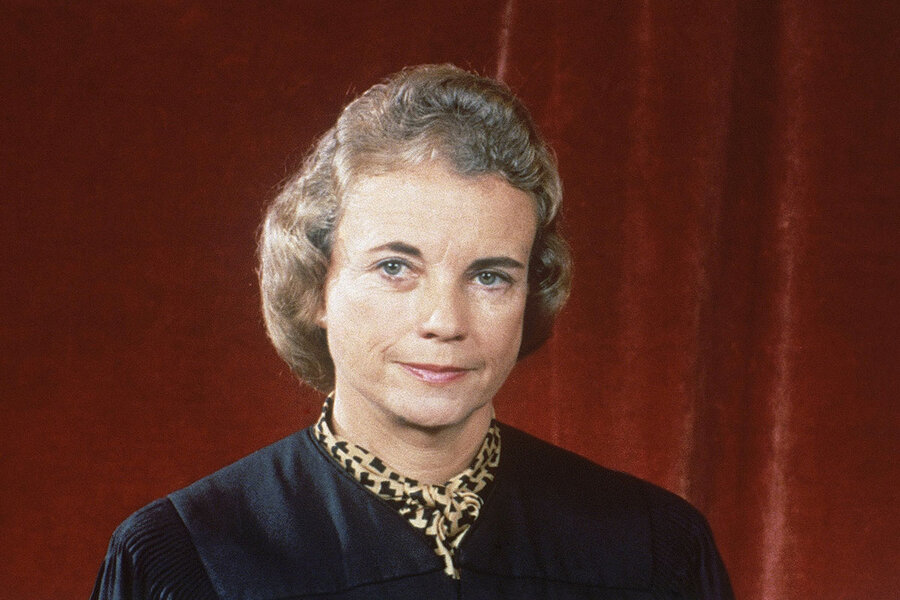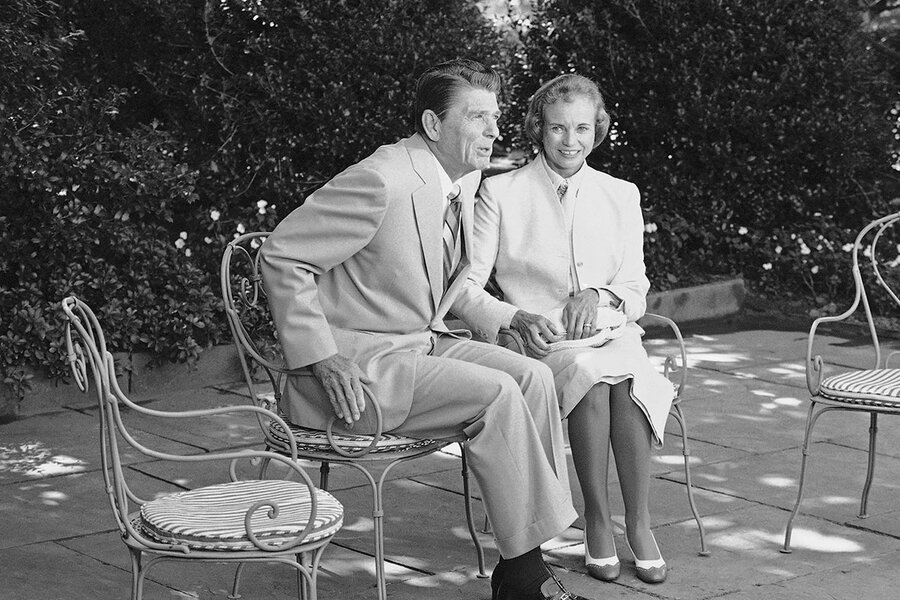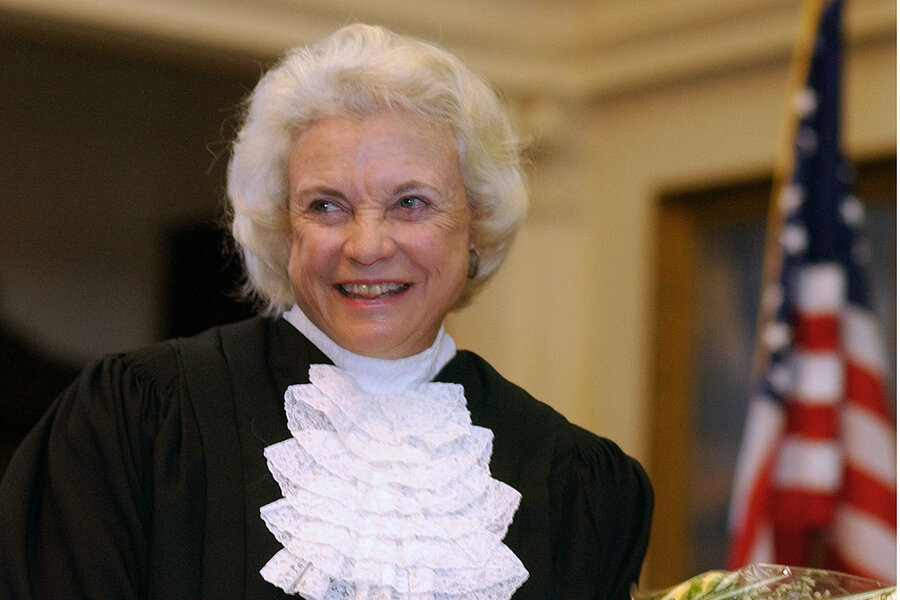Everything she did made history: Sandra Day O’Connor’s legacy
Loading...
| Austin, Texas
Sandra Day O’Connor, raised on a cattle ranch in the rural Southwest, shattered nearly 200 years of precedent when she joined the United States Supreme Court as the first female justice in 1981.
Justice O’Connor, who died Friday, left an indelible mark on American law and American society. For a time considered the most powerful woman in the country, she used her cautious and pragmatic approach to cases to shape the law on major issues ranging from abortion and affirmative action to executive branch war powers and the 2000 presidential election.
Why We Wrote This
Sandra Day O’Connor’s historic appointment as the first female justice of the U.S. Supreme Court opened doors to women. She brought compassion and pragmatism to a trailblazing career.
She was a trailblazer in more ways than one. Before she became a justice, she was the first woman to hold a leadership position in a state legislature, as the majority leader in the Arizona Senate. After she retired from the high court, she served as a leading advocate for civics education and judicial independence around the world.
“She made it easier for people to imagine women as judges, or full professors, or deans of law schools,” says Ruth McGregor, a former clerk for Justice O’Connor. “Once you have someone as a Supreme Court justice, doing the hardest job in law, you can’t really argue women can’t do something [else] in the law.”
Although the United States was founded, as John Adams once said, to be “a government of laws and not of men,” for more than two centuries it was almost exclusively men who wrote and interpreted those laws.
That was until Sandra Day O’Connor, raised on a remote cattle ranch in the rural Southwest, joined the United States Supreme Court.
Beyond shattering that glass ceiling, Justice O’Connor – who died Friday – left an indelible mark on American law and American society. For a time considered the most powerful woman in the country, she used her cautious and pragmatic approach to cases to shape the law on major issues ranging from abortion and affirmative action to executive branch war powers and the 2000 presidential election.
Why We Wrote This
Sandra Day O’Connor’s historic appointment as the first female justice of the U.S. Supreme Court opened doors to women. She brought compassion and pragmatism to a trailblazing career.
She was a trailblazer in more ways than one. Before she became a justice, she was the first woman to hold a leadership position in a state legislature, as the majority leader in the Arizona Senate. And after she retired from the high court she served as a leading advocate for civics education and judicial independence around the world. Tactfully – and sometimes bluntly – she asserted herself in the male-dominated realms of law and politics, paving the way for generations of women after her.
There have been five women justices on the Supreme Court since Justice O’Connor’s confirmation in 1981, but she can also be viewed as the end of an era – the last generation before the high court became dominated by Ivy League and federal appeals court graduates, a conservative but unpredictable jurist who thought always about the practical effects of the law.
“Justice O’Connor has a strong claim to be among the small handful of the most pivotal justices in the modern Supreme Court’s history,” says Justin Driver, a former clerk.
Aerobics and “consequentialism”
“Justice – At Last,” read the cover of Time magazine after her nomination to the Supreme Court. The U.S. Senate issued more press credentials for her confirmation hearing than for the Watergate hearings – and confirmed her with a 99-0 vote. Everything that followed that term was “astounding,” says Ruth McGregor, who clerked for Justice O’Connor that year.
“There were tears in the eyes of a lot of law clerks, including me, when she walked out from the curtain and took her place at the bench,” she adds. “That was such an important time for women in the law.”
Everything she did made history. The first woman ever to ask a question at oral argument. (The attorney talked over her.) The first woman ever to write an opinion. The first woman ever to write a dissent. Reporters noted every word and action, watched her drive to the court, watched her go out to dinner with her husband, John. Amid it all, she had to prove herself to her high court colleagues.
“She handled this all with a great deal of grace and with a great deal of calmness,” says Ms. McGregor. “It didn’t seem that she was under stress, but I think she must have been.”
One of her earliest impacts at the high court was to organize a morning aerobics class. The 8 a.m. sessions – for women only – quickly attracted members and custom T-shirts. (“Exercise Your Constitution, Motion Sustained”; “Loosen Up With The Supremes.”)
Justice O’Connor had little experience in constitutional law, having worked as a county court and state appeals court judge. But that experience in the lower reaches of the American judiciary gave her a keen interest in the practical effects the law had on ordinary people.
She disapproved of grand unifying theories of legal interpretation – such as originalism, a now prominent philosophy that the Constitution should be interpreted as its 18th century authors would have intended. They gave too little weight to the specific facts and context of cases. In “First,” a biography of Justice O’Connor, author Evan Thomas describes her judicial philosophy as “consequentialism.”
“She was very fact-based, she cared about the record, about the practical consequences” of a decision, says Mr. Thomas. “She was sympathetic to cases involving women and children.”
“Especially on the tough social issues like affirmative action and abortion,” he adds, she favored “inching the law forward, trying not to get too far ahead or behind of public opinion.”
“The O’Connor Court” rises
She had been nominated as part of a long-term response to what conservatives viewed as the liberal excesses of the Warren Court. Justice Harry Blackmun, in particular, feared that she would be the fifth vote to overturn his opinion in Roe v. Wade, the 1973 decision legalizing abortion.
Justice O’Connor instead advocated for preserving Roe while allowing states to restrict abortion access unless it placed an “undue burden” on the mother.
In 1992, the high court heard a challenge to a Pennsylvania law requiring a woman seeking an abortion to first get consent from her parents and inform her husband, among other requirements.
Justice O’Connor met secretly with moderate Justices David Souter and Anthony Kennedy to craft an opinion preserving most of Roe. Planned Parenthood v. Casey became one of the major precedents upholding abortion rights in America.
“I think Justice Kennedy trusted both her instinct on what would happen to the integrity of the court if they had gone so far as to overrule Roe completely, and also her notion about what would happen to women,” says Kathryn Kolbert, who argued against the Pennsylvania law before the Supreme Court. The spousal notice requirement, in particular, troubled the former state court judge.
“She had a really firm understanding of what women in abusive relationships go through,” adds Ms. Kolbert. “I didn’t always agree with every opinion she wrote, but I thought she was an incredibly conscientious justice, she was incredibly empathetic, she understood and looked to how laws affected real people.”
The Casey decision was part of a period where Justice O’Connor’s vote was so decisive the high court became known as “the O’Connor Court.” The moniker was “an exaggeration,” the justice said in 2011, though in 24 years on the bench, she was in the majority in 330 5-4 cases.
“She had a keen instinct about where the middle was, and what the country could stand,” said Mr. Thomas in a 2018 interview.
Above all, Justice O’Connor appreciated the need for the Supreme Court to be pragmatic and fix problems that were affecting the country.
That approach didn’t always pay off. When a recount in Florida held up the 2000 presidential election between George W. Bush and Al Gore, she was one of five justices – all nominated by Republican presidents – who voted to hear the case and, ultimately, stop a recount and hand the White House to President Bush. It was one of her few regrets in her career.
Instead of fixing a problem, “probably the Supreme Court added to the problem at the end of the day,” she said in a 2013 interview with the Chicago Tribune.
A whip-smart cowgirl
Growing up on the Lazy B Ranch, Sandra Day started to read at age 4 and learned to brand a calf and fire a rifle before her 10th birthday. Her childhood friends were the adult cowboys she would join on roundups.
Most importantly, the harsh realities of Depression-era ranch life taught her the values of selflessness and self-reliance, and forged a relentless work ethic she carried her entire life.
Tasked one blazing hot morning with bringing lunch to her father and the cowboys on a roundup, she blew a tire on the drive out and spent over an hour changing it. When she finally reached them, her father didn’t sympathize. “You should have started earlier,” he told her. “You need to expect anything out here.”
That became the message to generations of O’Connor law clerks: no excuses, the work has to get done no matter what.
“I assume you’re calling about secretarial work?”
In the spring of 1952, two promising young students graduated from Stanford University Law School. William Rehnquist and Sandra Day knew each other well – they had dated for a while, and he had even proposed to her.
She said no, but her former beau landed on his feet. Graduating first in his class, he left for Washington, D.C. to clerk for Justice Robert Jackson and would go on to serve as an associate justice and chief justice of the Supreme Court for 36 years.
Sandra Day graduated third in her class. The first woman to edit the Stanford Law Review, she called 40 law firms looking for a job. Only one gave her an interview: the Los Angeles firm Gibson, Dunn & Crutcher. “Well Miss Day,” she recalled the firm’s interviewer asking, “how well can you type?”
A few years later, her husband took a job at a law firm in Phoenix, Arizona. Again, no law firms were interested in hiring a woman. She opened a small law office in a suburban shopping center with another lawyer from Massachusetts.
Did it ever make her – third in her class at Stanford, first woman on law review – angry?
“Never anger, but, ‘Things will change,’ she said. ‘Things will change,’” recalls Gay Wray, a friend of the justice since her law practice days. “That sort of thing was never going to keep her down.”
It was in those years that she became a mother, giving birth to three sons, and became involved in state politics. She soon took a leading role in advancing womens’ rights – albeit incrementally – as a state lawmaker in Arizona.
Less than two months in, she helped pass legislation abolishing a state law limiting women to an eight-hour work day, but her record on women’s rights remained mixed. Most notably, she let the Equal Rights Amendment – a constitutional amendment that would have guaranteed equal legal rights for all Americans regardless of sex – die in committee, worried that it didn’t have the votes to pass. Arizona was one of six states to not ratify the amendment before a congressionally imposed 1979 deadline.
“Would I call her a feminist? No,” says Ms. Wray. “She was definitely for furtherment of women’s rights, but she would not knock down a man to do that. It was the best person for the job, that was always her thought.”
She later ran for, and won, a seat on the Maricopa County Superior Court – although she criticized the popular election of judges her entire career, and was one of the last popularly elected judges in the county.
By then, the O’Connors had become one of the most influential and popular families in Arizona politics. After Bruce Babbitt, a Democrat, became governor in 1978, a movement to draft her to challenge him in 1982 started to build. In 1979, however, a vacancy appeared on the state court of appeals, and Mr. Babbitt selected Justice O’Connor.
She didn’t serve on the Arizona Court of Appeals for long. Ronald Reagan won the presidency in 1980 having promised to nominate the first woman justice, and Justice Potter Stewart soon retired. Before long, the new Arizona appeals court judge got a call from William French Smith, President Reagan’s attorney general, about an interview for a “federal position.” Mr. Smith had been a partner at Gibson, Dunn & Crutcher, the Los Angeles law firm that had asked her three decades earlier how well she could type.
“I assume you’re calling about secretarial work?” she replied.
“A true love story”
The constant in her trailblazing path to the Supreme Court was John O’Connor. Their marriage had been one of mutual, unwavering support and sacrifice. She moved to Germany, then Phoenix, for the sake of his career, and he had moved to Washington for hers. In 2000 he was diagnosed with dementia and she cared for him – on top of all her work on the court – until 2006, when his condition worsened.
She had been contemplating retirement from the high court since 1996, Mr. Thomas wrote in his biography, but didn’t want a Democrat to nominate her successor. With George W. Bush in the White House, she decided to step down in 2006. Within six months of her retirement, however, her husband could no longer recognize her.
“He sacrificed for her and then she sacrificed for him. It’s a great love story,” says Mr. Thomas.
After he passed away in 2009 she devoted herself to traveling the U.S. and the world, advocating for judicial independence and civics education. iCivics, a nonprofit she founded in 2009 to transform and promote civics education in schools, still operates today.
She also watched with unease as her replacement, Justice Samuel Alito, helped an increasingly conservative court undo major aspects of her legacy, including upholding a ban on so-called partial-birth abortions, relaxing rules on campaign spending, and chipping away at affirmative action in schools. The court eventually overturned Roe last year, and affirmative action this past summer.
“She found it painful to watch some of her major legacies be eroded,” says Professor Driver, who clerked for her that first year after her retirement.
Her steadfast belief in treating each case in isolation, focusing on its specific facts and context and eschewing a broad judicial philosophy, disenchanted her with movement conservatives who were growing in number and influence.
When Donald Trump entered the White House in 2016 having promised to nominate reliable conservatives to the federal judiciary, the Supreme Court and lower courts shifted further to the right, most notably with the confirmations of Justices Neil Gorsuch, Brett Kavanaugh, and Amy Coney Barrett. The watchword in the Trump White House at the time – according to Ruth Marcus, author of a book on Justice Kavanaugh’s bitter confirmation fight – was “no more O’Connors.”
Today, Justice O’Connor’s legacy is visible across her home state. The Arizona State University law school bears her name, as does the federal courthouse in Phoenix. Sept. 25, the day she was sworn into the Supreme Court, has been celebrated as Sandra Day O’Connor Day in Arizona since 2018.
She withdrew from public life that year after being diagnosed with dementia. Friends and colleagues would say there could only ever be one Sandra Day O’Connor.
“She made it easier for people to imagine women as judges, or full professors, or deans of law schools,” says Ms. McGregor. “Once you have someone as a Supreme Court justice, doing the hardest job in law, you can’t really argue women can’t do something [else] in the law.”










